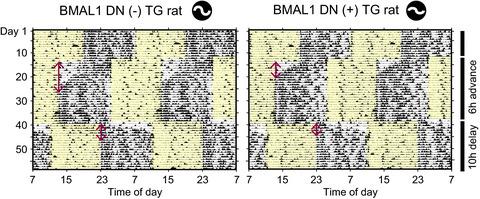当前位置:
X-MOL 学术
›
Eur. J. Neurosci.
›
论文详情
Our official English website, www.x-mol.net, welcomes your feedback! (Note: you will need to create a separate account there.)
Transgenic rats expressing dominant negative BMAL1 showed circadian clock amplitude reduction and rapid recovery from jet lag
European Journal of Neuroscience ( IF 3.698 ) Pub Date : 2020-12-22 , DOI: 10.1111/ejn.15085 Yoichi Minami 1 , Tomoko Yoshikawa 1 , Mamoru Nagano 1 , Satoshi Koinuma 1 , Tadamitsu Morimoto 1 , Atsuko Fujioka 1 , Keiichi Furukawa 1 , Keisuke Ikegami 1 , Atsuhiro Tatemizo 2 , Kentaro Egawa 2 , Teruya Tamaru 3 , Taizo Taniguchi 4 , Yasufumi Shigeyoshi 1
European Journal of Neuroscience ( IF 3.698 ) Pub Date : 2020-12-22 , DOI: 10.1111/ejn.15085 Yoichi Minami 1 , Tomoko Yoshikawa 1 , Mamoru Nagano 1 , Satoshi Koinuma 1 , Tadamitsu Morimoto 1 , Atsuko Fujioka 1 , Keiichi Furukawa 1 , Keisuke Ikegami 1 , Atsuhiro Tatemizo 2 , Kentaro Egawa 2 , Teruya Tamaru 3 , Taizo Taniguchi 4 , Yasufumi Shigeyoshi 1
Affiliation

|
The circadian rhythms are endogenous rhythms of about 24 h, and are driven by the circadian clock. The clock centre locates in the suprachiasmatic nucleus. Light signals from the retina shift the circadian rhythm in the suprachiasmatic nucleus, but there is a robust part of the suprachiasmatic nucleus that causes jet lag after an abrupt shift of the environmental lighting condition. To examine the effect of attenuated circadian rhythm on the duration of jet lag, we established a transgenic rat expressing BMAL1 dominant negative form under control by mouse Prnp‐based transcriptional regulation cassette [BMAL1 DN (+)]. The transgenic rats became active earlier than controls, just after light offset. Compared to control rats, BMAL1 DN (+) rats showed smaller circadian rhythm amplitudes in both behavioural and Per2 promoter driven luciferase activity rhythms. A light pulse during the night resulted in a larger phase shift of behavioural rhythm. Furthermore, at an abrupt shift of the light‐dark cycle, BMAL1 DN (+) rat showed faster entrainment to the new light‐dark cycle compared to controls. The circadian rhythm has been regarded as a limit cycle phenomenon, and our results support the hypothesis that modification of the amplitude of the circadian limit cycle leads to alteration in the length of the phase shift.
中文翻译:

表达显性负性BMAL1的转基因大鼠表现出昼夜节律振幅降低并从时差迅速恢复
昼夜节律是约24小时的内源性节律,并且由昼夜节律驱动。时钟中心位于视交叉上核。来自视网膜的光信号改变了视交叉上核中的昼夜节律,但是在环境照明条件突然变化后,视交叉上核中有一个坚固的部分会引起时差反应。为了检查昼夜节律的减缓对时差反应持续时间的影响,我们建立了转基因大鼠,该小鼠在基于小鼠Prnp的转录调控盒[BMAL1 DN(+)]的控制下表达BMAL1显性负性形式。只是在光线偏移后,转基因大鼠的活动早于对照。与对照大鼠相比,BMAL1 DN(+)大鼠在行为和生理方面均显示出较小的昼夜节律振幅Per2启动子驱动的萤光素酶活性节律。夜间的光脉冲导致行为节奏的较大相移。此外,在明暗周期的突然变化下,与对照组相比,BMAL1 DN(+)大鼠表现出更快的夹带到新的明暗周期。昼夜节律被认为是极限循环现象,我们的结果支持这样的假设,即对昼夜极限循环幅度的修改会导致相移长度的改变。
更新日期:2020-12-22
中文翻译:

表达显性负性BMAL1的转基因大鼠表现出昼夜节律振幅降低并从时差迅速恢复
昼夜节律是约24小时的内源性节律,并且由昼夜节律驱动。时钟中心位于视交叉上核。来自视网膜的光信号改变了视交叉上核中的昼夜节律,但是在环境照明条件突然变化后,视交叉上核中有一个坚固的部分会引起时差反应。为了检查昼夜节律的减缓对时差反应持续时间的影响,我们建立了转基因大鼠,该小鼠在基于小鼠Prnp的转录调控盒[BMAL1 DN(+)]的控制下表达BMAL1显性负性形式。只是在光线偏移后,转基因大鼠的活动早于对照。与对照大鼠相比,BMAL1 DN(+)大鼠在行为和生理方面均显示出较小的昼夜节律振幅Per2启动子驱动的萤光素酶活性节律。夜间的光脉冲导致行为节奏的较大相移。此外,在明暗周期的突然变化下,与对照组相比,BMAL1 DN(+)大鼠表现出更快的夹带到新的明暗周期。昼夜节律被认为是极限循环现象,我们的结果支持这样的假设,即对昼夜极限循环幅度的修改会导致相移长度的改变。



























 京公网安备 11010802027423号
京公网安备 11010802027423号